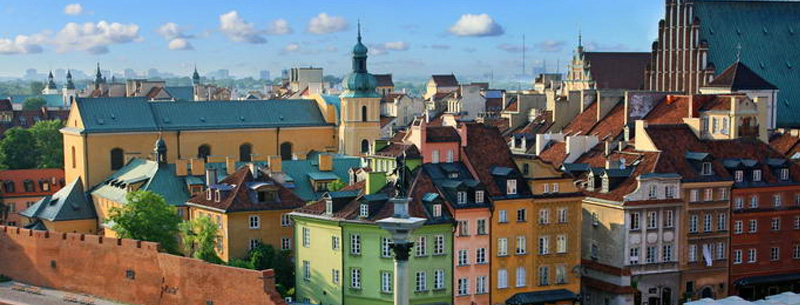Gdansk has the glittering seashore, and Krakow has undeniable beauty, but the Polish capital of Warsaw is the country’s most cultured, energetic and action-packed city. The capital has enjoyed a remarkable rebirth since it was flattened during the Second World War, and it continues to grow and evolve at an accelerated pace. Today, the city’s thriving energy and funky vibe is positively infectious.
Start your visit at the Royal Castle, a remarkable copy of the 14th-century original, blown to bits by the Nazis near the finale of the war. The castle was once one of the most splendid royal residences in Europe, and its Baroque apartments have housed both tsars and presidents. Visitors can explore two of the castle’s floors, featuring many impressive rooms like the Parliament Chambers, Great Apartments and the magnificent Great Assembly Hall. The blinged-out space dazzles with golden columns, colorful ceiling paintings, marble medallions and gilded stucco. The next-door National Hall features six huge canvases that tell the story of Poland’s history in addition to portraits of 22 Polish kings, and the lavishly decorated Throne Room is bedecked in gold trimming, eagles made of silver wire and 23 paintings by Bernardo Bellotto that were used to reconstruct the city’s historic landmarks following the war.
The city’s Old Town was also reduced to rubble during the war but was painstakingly restored between 1949 and 1963, and every single architectural fragment recovered from the ruins was used in the restoration. The Old Town Square harmoniously blends baroque, Gothic and Renaissance elements, creating a lively atmosphere with art stalls and open-air cafes. The north side of the square is occupied by the Historical Museum of Warsaw, which provides a good introduction to the capital through documents, photographs and films.
Across town on the edge of the former ghetto lies the Warsaw Rising Museum. Housed in an amazingly restored redbrick building, the museum tells the story of the 1944 Rising’s history through film archives, interactive displays and photographs. The most moving part of the museum is the video footage, audio recordings and personal accounts of the insurgents’ heroic struggles.
The site of the Warsaw ghetto will soon be the home of the Museum of the History of the Polish Jews, slated to open in spring, 2013. More than 150 experts from around the country have contributed to the museum, which will feature multimedia exhibits dedicated to Poland’s vibrant Jewish community.
Other notable museums in the city include the Palace of Culture and Science, the National Museum and the Chopin Museum, which celebrates the composer’s life and work. More interesting sights include the grand Wilanow Palace, the beautifully manicured Lazienki Park, the old political prison Muzeum Pawilon-X, the eastern suburb of Praga, known for its creative population and pre-WWII buildings, the majestic Palace on the Water and the massive Citadel that overlooks the Vistula.
At night, head to New World Street, where fashionable Poles sip strong drinks at cafes, dine on international delicacies at posh restaurants and dance the night away to live bands and energetic DJs. The capital boasts every type of entertainment imaginable, from luxe lounges to boho bars and packed techno joints where strobe lights illuminate crowds of hundreds.
Warsaw Geographical Location
Warsaw is east of Poland’s center on the Vistula River. It is the largest city in Poland with a population of 2,800,000 in its metropolitan area.
Warsaw Language
Polish is the official language of Poland and is spoken by the vast majority of its inhabitants. The younger generation of Poles also speak English well as it is taught in school from a young age.
Warsaw Predominant Religion
- 90% Roman Catholic
- 1% Eastern Orthodox
- 9% Other
Poland is a religious country with the Church being highly revered but also guarantees religious freedom to all.
Warsaw Currency
The Zloty is the official currency of Poland.
Warsaw Climate
The winters are normally cold in Warsaw but the summers are warm and mild with June through August being the hottest.
Warsaw Main Attractions
- Old Town
- Palace of Culture and Science
- Frederick Chopin Museum
Other Attraction in Warsaw
- University of Warsaw
- Lazienki Park
- Warsaw Rising Museum
- Nowy Swiat
